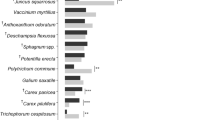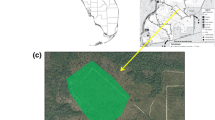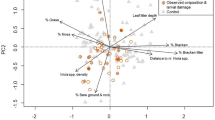Abstract
The frosted elfin (Callophrys irus) is a localized and declining butterfly found in xeric open habitats maintained by disturbance. We described the effects of woody plant canopy cover, topography and host plant size and density on the quality of microhabitat of wild indigo (Baptisia tinctoria) host plants containing late instar frosted elfin larvae at four study sites in southeastern Massachusetts, United States. We also assessed whether females preferentially depositing eggs on host plants within specific microhabitats, therefore conferring greater survivorship to the larvae through the late-instar stage. We found that moderate amounts of canopy cover and large plant size characterized larvae-occupied host plants. In the absence of tree canopy cover, late instar larvae density remained low even when host plant density was high. However, females oviposited on wild indigo plants without regard to any of the vegetative or environmental variables we measured. These results indicate that canopy cover was an important characteristic of microhabitats containing late instar larvae, and late instar larvae occupancy was determined by suitable microhabitat conditions, and not female oviposition selection. Managing for canopy cover and microhabitat heterogeneity within relatively open habitats is recommended for the maintenance of frosted elfin populations.





Similar content being viewed by others
References
Albanese G, Nelson MW, Vickery PD, Sievert PR (2007a) Larval feeding behavior and ant association in frosted elfin, Callophrys irus (Lycaenidae). J Lep Soc 61:61–66
Albanese G, Vickery PD, Sievert PR (2007b) Habitat characteristics of adult frosted elfins (Callophrys irus) in sandplain communities of southeastern Massachusetts, USA. Biol Conserv 136:53–64
Anthes N, Fartmann T, Hermann G, Kaule G (2003) Combining larval habitat quality and metapopulation structure—the key for successful management of pre-alpine Euphydryas aurnia colonies. J Insect Conserv 7:175–185
Baylis M, Pierce NE (1991) The effect of host-plant quality on the survival of larvae and oviposition by adults of an ant-tended lycaenid butterfly, Jalmenus evagoras. Ecol Entomol 16:1–9
Bergman KO (1999) Habitat utilization by Lopinga achine (Nymphalidae: Satyrinae) larvae and ovipositioning females: implications for conservation. Biol Conserv 88:69–74
Bourn NAD, Thomas JA (1993) The ecology and conservation of the brown argus butterfly Aricia agestis in Britain. Biol Conserv 63:67–74
Braun-Blanquet J (1964) Pflanzensoziologie. Springer-Verlag Inc., New York
Breiman L, Friedman JH, Olsen RA, Stone CG (1984) Classification and regression trees. Wadsworth International Group, Belmont, CA
Britten HB, Riley L (1994) Nectar source diversity as an indicator of habitat suitability for the endangered Uncompahgre fritillary, Boloria acrocnema (Nymphalidae). J Lep Soc 48:173–179
Cates RG, Henderson CB, Redak RA (1987) Responses of the western spruce budworm to varying levels of nitrogen and terpenes. Oecologia 73:312–316
Collinge SK, Prudic KL, Oliver JC (2003) Effects of local habitat characteristics and landscape context on grassland butterfly diversity. Conserv Biol 17:178–187
Cushman JH, Rashbrook VK, Beattie AJ (1994) Assessing benefits to participants in a lycaenid-ant association. Ecology 75:1031–1041
Damman H, Feeny P (1988) Mechanisms and consequences of selective oviposition by the zebra swallowtail butterfly. Anim Behav 36:563–573
De’ath G, Fabricius KE (2000) Classification and regression trees: a powerful yet simple technique for ecological data analysis. Ecology 81:3178–3192
Dennis RLH, Shreeve TG, Van Dyck H (2003) Towards a functional resource-based concept for habitat: a butterfly biology viewpoint. Oikos 102:417–426
Dennis RLH, Shreeve TG, Van Dyck H (2006) Habitats and resources: the need for a resource-based definition to conserve butterflies. Biodivers Conserv 15:1943–1966
Dobkin DS, Olivieri I, Ehrlich PR (1987) Rainfall and the interaction of microclimate with larval resources in the population dynamics of checkerspot butterflies (Euphydryas editha) inhabiting serpentine grassland. Oecologia 71:161–166
Ehrlich PR, Murphy DD, Singer MC, Sherwood CB, White RR, Brown IL (1980) Extinction, reduction, stability and increase: the response of the checkerspot butterfly (Euphydryas) populations to the California drought. Oecologia 46:101–105
Environmental Systems Research Institute (ESRI). (1999–2004). ArcGIS (9.0). ESRI, Redlands, CA
Gilbert LE, Singer MC (1975) Butterfly ecology. Annu Rev Ecolog Syst 6:365–397
Goldstein PZ (1999) Functional ecosystems and biodiversity buzzwords. Conserv Biol 13:247–255
Grundel R, Pavlovic NB, Sulzman CL (1998a) The effect of canopy cover and seasonal change on host plant quality for the endangered Karner blue butterfly (Lycaeides melissa samuelis). Oecologia 114:243–250
Grundel R, Pavlovic NB, Sulzman CL (1998b) Habitat use by the endangered Karner blue butterfly in oak woodlands: the influence of canopy cover. Biol Conserv 85:47–53
Grundel R, Pavlovic NB, Sulzman CL (2000) Nectar plant selection by the Karner blue butterfly (Lycaeides melissa samuelis) at the Indiana Dunes National Lakeshore. Am Midl Nat 144:1–10
Hochberg ME, Clarke RT, Elmes GW, Thomas JA (1994) Population dynamic consequences of direct and indirect interactions involving a large blue butterfly and its plant and red ant hosts. J Anim Ecol 63:375–391
Konvicka M, Hula V, Fric Z (2003) Habitat of the prehibernating larvae of the endangered butterfly Euphydryas aurina (Lepidoptera: Nymphalidae): what can be learned from vegetation composition and architecture. Eur J Entomol 100:313–322
Lane C (1999) Benefits of a heterogeneous habitat: oviposition preference and immature performance of Lycaeides melissa samuelis Nobakov (Lepidoptera: Lycaenidae). Dissertation, University of Minnesota, St. Paul, MN
Lane CP, Andow DA (2003) Oak savanna subhabitat variation in the population biology of Lycaeides Melissa samuelis (Lepidoptera: Lycaenidae). Ann Entom Soc Am 96:799–809
Layberry RA, Hall PW, Lafontaine JD (1998) The butterflies of Canada. University of Toronto Press, Toronto, ON
Lemmon PE (1956) A spherical densiometer for estimating forest overstory density. For Sci 2:314–320
Mattson WJ (1980) Herbivory in relation to plant nitrogen content. Annu Rev Ecol Syst 11:119–161
Mohr CO (1947) Table of equivalent populations of North American mammals. Am Midl Nat 37:223–249
Murphy DD, Freas KE, Weis SB (1990) An environment-metapopulation approach to population viability analysis for a threatened invertebrate. Conserv Biol 4:41–51
NatureServe (2006) NatureServe Explorer: an online encyclopedia of life [web application]. Version 4.6. NatureServe, Arlington, Virginia. http://www.natureserve.org/explorer. Cited 15 March 2006
New TR (2007) Understanding the requirements of the insects we seek to conserve. J Insect Conserv 11:95–97
Ohsaki N, Sato Y (1994) Food plant choice of Pieris butterflies as a trade-off between parasitoid avoidance and quality of plants. Ecology 75:59–68
Opler PA, Pavulaan H, Stanford RE (1995) Butterflies of North America. Northern Prairie Wildlife Research Center home page, Jamestown, ND. http://www.npwrc. usgs.gov/ resource/distr/lepid/bflyusa/bflyusa.htm. Cited 15 April 2006
Opler PA (1998) A field guide to eastern butterflies. Houghton Mifflin Company, Boston, MA
Packer L (1998) Status report on the frosted elfin butterfly (Incisalia irus, Godart) in Canada. Department of Biology, York University, Toronto, ON
Pierce NE, Braby MF, Heath A, Lohman DJ, Mathew J, Rand DB, Travassos MA (2002) The ecology and evolution of ant association in the Lycaenidae (Lepidoptera). Annu Rev Entomol 47:733–771
Pollard E (1988) Temperature, rainfall and butterfly numbers. J Appl Ecol 25:819–828
Quinn RM, Gaston KJ, Roy DB (1988) Coincidence in the distributions of butterflies and their foodplants. Ecography 21:279–288
Rausher MD (1979) Larval habitat suitability and oviposition preference in three related butterflies. Ecology 60:503–511
Rausher MD (1981) Host plant selection by Battus philenor butterflies: the roles of predation, nutrition and plant chemistry. Ecol Monogr 51:1–20
Rausher MD, Papaj DR (1983) Demographic consequences of discrimination among conspecific host plants by Battus philenor butterflies. Ecology 64:1402–1410
Ravenscroft NOM (1994a) The ecology of the chequered skipper butterfly Carterocephalus palaemon in Scotland. I. Microhabitat. J Appl Ecol 31:613–622
Ravenscroft NOM (1994b) The ecology of the chequered skipper butterfly Carterocephalus palaemon in Scotland II. Foodplant quality and population range. J Appl Ecol 31:623–630
R Development Core Team (2004) R: a language and environment for statistical computing. R Foundation for Statistical Computing, Vienna, Austria
Sato Y, Ohsaki N (1987) Host-habitat location by Apanteles glomeratus and the effect of food-plant exposure on host-parasitism. Ecol Entomol 12:291–297
Scott JA (1986) The butterflies of North America, a natural history and field guide. Stanford University Press. Stanford, CA
Scriber JM, Slansky F Jr (1981) The nutritional ecology of immature insects. Annu Rev Entomol 26:183–211
Shreeve TG (1986) Habitat selection, mate location, and microclimatic constraints on the activity of the speckled wood butterfly Pararge aegeria. Oikos 42:371–377
Simpson SL, Simpson CL (1990) The mechanisms of nutritional compensation by phytophagous insects. In: EA Bernays (ed), Insect-plant interactions. CRC Press, Cleveland, OH, pp 111–160
Singer MC (1972) Complex components of habitat suitability within a butterfly colony. Science 176:75–77
Slansky F Jr, Scriber JM (1985) Food consumption and utilization. In: Kerkut GA, Gilbert LJ (eds) Comprehensive insect physiology, biochemistry and pharmacology IV. Pergamon Press, Oxford, UK, pp 87–163
Slansky F Jr (1993) Nutritional ecology: the fundamental quest for nutrients. In: Stamp NE, Casey TM (eds) Caterpillars: ecological and evolutionary constraints on foraging. Chapman & Hall, New York, NY, pp 29–91
Smallidge PJ, Leopold DJ, Allen CM (1996) Community characteristics and vegetation management of Karner Blue Butterfly (Lycaeides melissa samuelis) on rights-of-way in east-central New York, USA. J Appl Ecol 33:1405–1419
Statistical Analysis System (SAS) (2003) Release 9.1 edn. SAS Institute Inc., Cary, NC
Swain PC, Kearsley JB (2001) Classification of the natural communities of Massachusetts. Natural Heritage and Endangered Species Program, Massachusetts, Division of Fisheries and Wildlife, Westborough, MA
Swengel AB (1995) Observations of spring larvae of Lycaeides melissa samuelis (Lepidoptera: Lycaenidae) in central Wisconsin. Gt. Lakes Entomol 28:155–170
Taylor MFJ (1988) Field measurements of the dependence of life history on plant nitrogen and temperature for a herbivorous moth. J Anim Ecol 57:873–891
Thomas JA (1984) The behavior and habitat requirements of Maculinea nausithous (the dusky large blue butterfly) and M. teleius (the scarce large blue) in France. Biol Conserv 28:325–347
Thompson JN (1988) Evolutionary ecology of the relationship between oviposition preference and performance of offspring of phytophagous insects. Entomol Exp Appl 47:3–14
Wagner D, Kurina L (1997) The influence of ants and water availability on oviposition behavior and survivorship of a facultatively ant-tended herbivore. Ecol Entomol 22:352–360
Wagner DL, Nelson NW, Schweitzer DF (2003) Shrubland Lepidoptera of southern New England and southeastern New York: ecology, conservation, and management. For Ecol Manag 185:95–112
Warren MS (1987) The ecology and conservation of the heath fritillary, Mellicta athalia III. Population dynamics and the effect of habitat management. J Appl Ecol 24:499–513
Weiss SB, Murphy DD, White RR (1988) Sun, slope, and butterflies; topographic determinants of habitat quality for Euphydryas editha. Ecology 69:1486–1496
Wiklund C (1977) Oviposition, feeding and spatial separation of breeding and foraging habitats in a population of Leptidea sinapis (Lepidoptera). Oikos 28:56–68
Wiklund C (1984) Egg-laying patterns in butterflies in relation to their phenology and the visual apparency and abundance of their host plant. Oecologia 63:23–29
Zangerl AR, Berenbaum MR (1992) Oviposition patterns and host plant suitability: parsnip webworms and wild parsnip. Am Midl Nat 128:292–298
Acknowledgments
K. McGarigal, M. W. Nelson, and E. M. Steinauer provided valuable reviews and their comments greatly improved this manuscript. We gratefully acknowledge funding and support from the Natural Heritage and Endangered Species Program, of the Massachusetts Division of Fisheries and Wildlife, The Massachusetts Environmental Trust, The Massachusetts Audubon Society, The Nature Conservancy and The Trustees of Reservations. We would also like to thank all the volunteers that contributed their efforts to this project. A special thanks to Stephanie and Skyesha Albanese, Richard Couse, Brad Compton, Mark Mello, Andrea Jones, and Tim Simmons whose help made this project possible.
Author information
Authors and Affiliations
Corresponding author
Rights and permissions
About this article
Cite this article
Albanese, G., Vickery, P.D. & Sievert, P.R. Microhabitat use by larvae and females of a rare barrens butterfly, frosted elfin (Callophrys irus). J Insect Conserv 12, 603–615 (2008). https://doi.org/10.1007/s10841-007-9097-2
Received:
Accepted:
Published:
Issue Date:
DOI: https://doi.org/10.1007/s10841-007-9097-2




